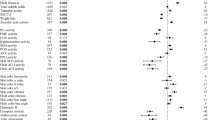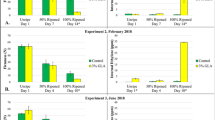Abstract
FLESHY fruits have been divided into two classes on the basis of their respiratory behaviour during ripening: climacteric fruit, such as bananas, which undergo a large increase in respiration (climacteric rise) accompanied by marked changes in composition and texture, and non-climacteric fruit such as citrus, which show no changes in respiration that can be associated with distinct changes in the composition of the fruit1. An increase in the level of endogenous ethylene is considered to be the immediate trigger of ripening in climacteric fruits2. Fruits of this class usually produce large amounts of ethylene once ripening is under way. They may also be induced to ripen by treatment with ethylene at concentrations above about 0.1 p.p.m. for a suitable period3. The ripening induced by exogenous ethylene has been considered to be qualitatively identical with that which occurs naturally3. In both cases, once ripening is induced it has been considered that endogenous ethylene production rises autocatalytically4. Uninjured citrus fruit have been shown to produce low amounts of ethylene5. Their respiration may be increased by treatment with ethylene6 and disappearance of chlorophyll (colouring) and ageing may be more rapid18.
This is a preview of subscription content, access via your institution
Access options
Subscribe to this journal
Receive 51 print issues and online access
$199.00 per year
only $3.90 per issue
Buy this article
- Purchase on Springer Link
- Instant access to full article PDF
Prices may be subject to local taxes which are calculated during checkout
Similar content being viewed by others

References
Biale, J. B., in Encyclopedia of Plant Physiology, 12, 536 (1960).
Pratt, H. K., and Goeschl, J. D., Ann. Rev. Plant Physiol., 20, 541 (1969).
McGlasson, W. B., in The Biochemistry of Fruits and Their Products (edit. by Hulme, A. C), 475 (Academic Press, London and New York, 1970).
Burg, S. P., and Burg, E. A., Science, 148, 1190 (1965).
Burg, S. P., and Burg, E. A., Plant Physiol., 37, 179 (1962).
Biale, J. B., Science, 146, 880 (1964).
Vendrell, M., and McGlasson, W. B., Austral. J. Biol Sci. (in the press).
Burg, S. P., and Burg, E. A., Plant Physiol., 42, 144 (1967).
McGlasson, W. B., Austral. J. Biol. Sci., 22, 489 (1969).
Palmer, J. K., and McGlasson, W. B., Austral. J. Biol. Sci., 22, 87 (1969).
Brady, C. J., O'Connell, P. B. H., Smydzuk, J., and Wade, N. L., Austral. J. Biol. Sci., 23, 1143 (1970).
Quazi, M. H., and Freebairn, H. T., Bot. Gaz., 131, 5 (1970).
Sacher, J. A., Plant Physiol., 41, 701 (1966).
Rasmussen, G. K., Furr, J. R., and Cooper, W. C., J. Amer. Soc. Hort. Sci., 94, 640 (1969).
Cooper, W. C., Rasmussen, G. K., and Hutchison, D. J., Bioscience, 19, 443 (1969).
Eaks, I. L., Plant Physiol., 45, 334 (1970).
Reid, M. S., and Pratt, H. K., Nature, 226, 976 (1970).
Winston, J. R., US Dept. Agric. Circ., No. 961 (1955).
Author information
Authors and Affiliations
Rights and permissions
About this article
Cite this article
MCMURCHIE, E., MCGLASSON, W. & EAKS, I. Treatment of Fruit with Propylene gives Information about the Biogenesis of Ethylene. Nature 237, 235–236 (1972). https://doi.org/10.1038/237235a0
Received:
Issue Date:
DOI: https://doi.org/10.1038/237235a0
This article is cited by
-
Regulation of wound ethylene biosynthesis by NAC transcription factors in kiwifruit
BMC Plant Biology (2021)
-
SlGRAS4 accelerates fruit ripening by regulating ethylene biosynthesis genes and SlMADS1 in tomato
Horticulture Research (2021)
-
The tomato HIGH PIGMENT1/DAMAGED DNA BINDING PROTEIN 1 gene contributes to regulation of fruit ripening
Horticulture Research (2019)
-
An artificial metalloenzyme biosensor can detect ethylene gas in fruits and Arabidopsis leaves
Nature Communications (2019)
-
Diversity and redundancy of the ripening regulatory networks revealed by the fruitENCODE and the new CRISPR/Cas9 CNR and NOR mutants
Horticulture Research (2019)
Comments
By submitting a comment you agree to abide by our Terms and Community Guidelines. If you find something abusive or that does not comply with our terms or guidelines please flag it as inappropriate.


